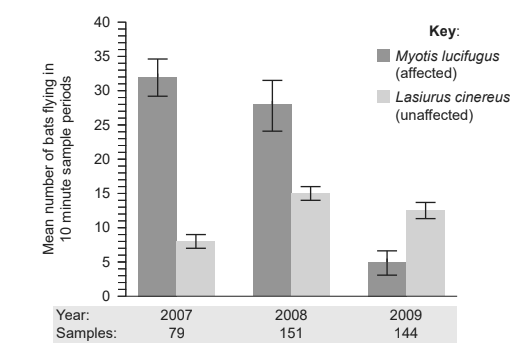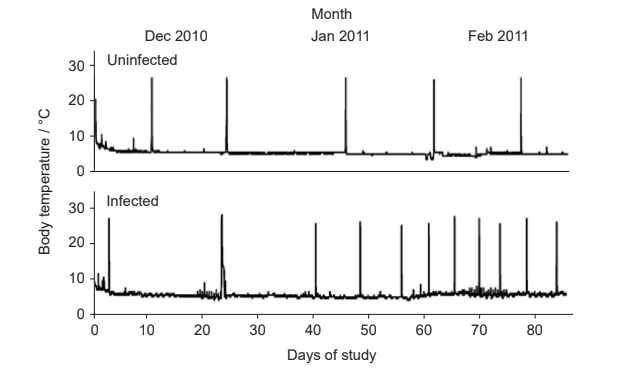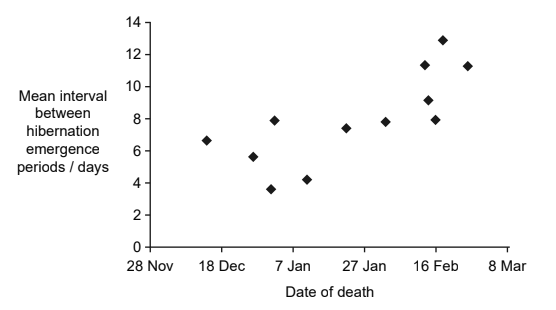Question
White-nose syndrome (WNS) is a disease caused by the fungus Geomyces destructans . This kills bats from many species during their winter hibernation . Scientists used echolocation to record the number of bat flights over a station in 10 minute sample periods during the summers of 2007 to 2009. The graph shows the mean number of flights and number of recording samples for little brown bats (Myotis lucifugus), a species affected by the fungus, along with those of hoary bats (Lasiurus cinereus), which are not affected.

(a). Calculate the total number of M. lucifugus flights that were recorded in the summer of 2007 . [1]
(b). Suggest one limitation of this recording method in determining the accurate mean number of individual bats flying. [1]
(c) (i) Calculate the percentage decline in the mean number of M. lucifugus flights for 2009 when compared to 2008.
(c) (ii) Evaluate the conclusion that the decline in the population of M. lucifugus is due to infection by the fungus .
Scientists have hypothesised that bats affected by WNS could be more likely than unaffected bats to emerge from hibernation during the winter. Bats occasionally undergo short interruptions in hibernation accompanied by an increase in body temperature . Scientists used sensors attached to M. lucifugus to monitor the temperature of a group infected with the fungus over the winter months . A second uninfected group was also monitored . The graphs show the results for two typical individuals .

(d). Distinguish between the patterns of hibernation of the uninfected and infected bats .
(e). Based on the data and your biological knowledge, suggest how the infection could lead to premature death in a bat .
The graph shows data from a small group of infected bats that died during hibernation . The average time interval between hibernation emergence periods and the date of death were recorded using temperature sensors for these bats .

(f). Outline the relationship between date of death and the mean interval between hibernation emergence periods .
(g). Discuss whether the data in the graph show that there is a causal link between the date of death and the interval between hibernation emergence periods .
(h). Suggest one reason, other than the interval between hibernation emergence periods, for some infected bats surviving longer than others .
(i). Using all of the data, predict the effect of WNS on bat populations.
Answer/Explanation
Ans:
a) (32 × 79 =) 2528
b)
a. same bat may be recorded more than once
b. some bats may not fly over [the recording station]
OR
only bats flying over the station are recorded
c. two bats flying close/together might be recorded as one
c (i) 82 / 82.1 / 82.14 (% decline)
c ii Conclusion supported (2008 to 2009) M. lucifugus declines more (than L. cinereus) OR (2007 to 2009) M. lucifugus declines whereas L. cinereus increases/fluctuates/did not decline OR more affected than unaffected bats in 2007 and 2008 but more unaffected in 2009 Conclusion not supported other factors could be causing the difference between the species/the decrease in M. lucifugus OR there will be differences between the two bat species apart from WNS infection OR both species decreased from 2008 to 2009
d)
a. more (frequent) interruptions/emergences from hibernation/shorter periods of
hibernation/more spikes in temperature (indicating emergence) in infected bats
b. more fluctuation in (body) temperature (during hibernation) in infected (than uninfected bats)
c. emergences/interruptions become more frequent during the hibernation period in infected bats versus (about) about the same frequency in uninfected
e)
a. energy needed to raise body temperature / lost during temperature spikes
b. energy/heat released by/comes from (cell) respiration/metabolism
c. food/fat (stores/reserves) used in (cell) respiration/in generating energy/heat/raising body temperature
d. bats die/starve if fat/energy/food stores used up
e. hibernation conserves food stores/reduces use of energy
f. no/little food available/food harder to find (in winter/during hibernation period)
g. (more) energy/food used when flying/hunting
h. (more) heat loss/hypothermia (in winter/cold weather)
i. higher chance of being killed by predators when flying/emerged from hibernation
(f ) later date of death with longer/bigger intervals (between hibernation emergence)/with less frequent interruptions (to hibernation) The correlation must be described.
g)
Arguments for a causal link
a. there is a trend/correlation/relationship (shown by the data in the graph)
b. explanations of how more frequent emergence from hibernation could cause earlier death (are plausible)/example of an explanation
Arguments against a causal link
c. there is a correlation but this does not show a causal link / correlation does not prove causation
d. more data/further research is needed to show the causes
e. there is (much) variation/spread in the data
f. other factors can affect the date of death
h)
a. differences in body mass
OR
differences in reserves/stores of food/energy/fat
b. bats may be predated during a flight / chance events might affect the date of death
c. more effective/stronger immune system/immunity (in some bats)
d. more resistance to cold (in some bats)
e. larger bats lose heat less rapidly
f. infected at a different/later date
i)
a. higher mortality/more deaths $\checkmark$
b. shorter life expectancy/premature death/death before reproduction $\checkmark$
c. extinction/reduction in (size of) of bat populations $\checkmark$
d. L. cinereus/species of bats not affected by WNS may increase OR
L. cinereus/species of bats not affected by WNS may experience less competition $\checkmark$
e. infection may affect birth rates/fertility $\checkmark$
f. bats will emerge more from hibernation/in winter $\checkmark$
g. bats will use up food/energy reserves faster in winter/faster due to (more) interruptions $\sqrt{ }$
Question
(a) State two features that are found only in mammals . [2]
(b) Birds, bats and humans are all vertebrates with pentadactyl limbs. Birds and bats use their forelimbs to fly whereas humans can use them to lift and manipulate objects.
Outline how the bird, bat and human forelimb can be used to illustrate the concept of homologous structures.
Answer/Explanation
Ans:
a)
a. hair/fur
b. mammary glands/breasts/(secretion of) milk/lactation
c. sweat glands
d. lungs with alveoli
e. placenta (in most mammals)
f. fetus develops in uterus/gives birth to live young
b)
a. (homologous structures have evolved) from a common ancestor
b. divergent evolution/adaptive radiation
c. similarities in forelimb bones (in birds, bats and humans) / description of the similarities in bones
